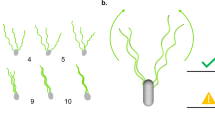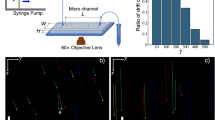Abstract
Certain bacteria, such as Escherichia coli (E. coli) and Salmonella typhimurium (S. typhimurium), use multiple flagella often concentrated at one end of their bodies to induce locomotion. Each flagellum is formed in a left-handed helix and has a motor at the base that rotates the flagellum in a corkscrew motion.We present a computational model of the flagellar motion and their hydrodynamic interaction. The model is based on the equations of Stokes flow to describe the fluid motion. The elasticity of the flagella is modeled with a network of elastic springs while the motor is represented by a torque at the base of each flagellum. The fluid velocity due to the forces is described by regularized Stokeslets and the velocity due to the torques by the associated regularized rotlets. Their expressions are derived. The model is used to analyze the swimming motion of a single flagellum and of a group of three flagella in close proximity to one another. When all flagellar motors rotate counterclockwise, the hydrodynamic interaction can lead to bundling. We present an analysis of the flow surrounding the flagella. When at least one of the motors changes its direction of rotation, the same initial conditions lead to a tumbling behavior characterized by the separation of the flagella, changes in their orientation, and no net swimming motion. The analysis of the flow provides some intuition for these processes.
Similar content being viewed by others
References
Berg, H.C., 2003. The rotary motor of bacterial flagella. Annu. Rev. Biochem. 72, 19–54.
Berry, R.M., 2001. Bacterial flagella: Flagellar motor. In: Nature Encyclopedia of Life Sciences. Nature Publishing Group, http://www.els.net.
Cortez, R., 2001. The method of regularized Stokeslets. SIAM J. Sci. Comput. 23, 1204–1225.
Cortez, R., Fauci, L., Medovikov, A., 2004. The method of regularized Stokeslets in three dimensions: analysis, validation, and application to helical swimming. Phys. Fluids (in press).
Dillon, R., Fauci, L., 2000. An integrative model of internal axoneme mechanics and external fluid dynamics in ciliary beating. J. Theor. Biol. 207, 415–430.
Goto, T., Inaoka, R., Takano, Y., 1999. A boundary element analysis of swimming bacteria with several flagella. In: Proceedings of the Bioengineering Conference. ASME, Big Sky, Montana, June 16–20, 1999.
Goto, T., Masuda, S., Terada, K., Takano, Y., 2001. Comparison between observation and boundary element analysis of bacterium swimming motion. JSME Int. J. Ser. C 44, 958–963.
Gray, J., 1968. Animal Locomotion. Weidenfeld&Nicolson, London.
Higdon, J.J.L., 1979a. A hydrodynamic analysis of flagellar propulsion. J. Fluid Mech. 90, 685–711.
Higdon, J.J.L., 1979b. The hydrodynamics of flagellar propulsion: helical waves. J. Fluid Mech. 94, 331–351.
Jones, C.J., Aizawa, S.I., 1991. The bacterial flagellum and flagellar motor: structure, assembly and function. J. Mol. Biol. 32, 109–172.
Kamiya, R., Asakura, S., 1976. Helical transformations of salmonella flagella in vitro. J. Mol. Biol. 106, 167–186.
Kim, M.J., Bird, J.C., Van Parys, A.J., Breuer, K.S., Powers, T.R., 2003. A macroscopic scale model of bacterial flagellar bundling. Proc. Natl. Acad. Sci. USA 100, 15481.
Lighthill, M.J., 1976. Flagellar hydrodynamics. SIAM Rev. 18, 161–230.
Lighthill, M.J., 1996. Helical distributions of Stokeslets. J. Eng. Math. 30, 35–78.
Lim, S., Peskin, C.S., 2004. Simulations of the whirling instability by the immersed boundary method. SIAM J. Sci. Comput. 25, 2066–2083.
McClaine, J.W., Ford, R.M., 2002. Reversal of flagellar rotation is important in initial attachment of Escherichia coli to glass in a dynamic system with high-and low-ionic-strength buffers. Appl. Environ. Microbiol. 68, 1280–1289.
Peskin, C.S., 2002. The immersed boundary method. Acta Numeri. 11, 479–517.
Powers, T.R., 2002. Role of body rotation in bacterial flagellar motion. Phys. Rev. E 65, 040903(R).
Purcell, E.M., 1997. The efficiency of propulsion by a rotating flagellum. Proc. Natl. Acad. Sci. USA 94, 24–29.
Ramia, M., Tullock, D.L., Phan-Thien, N., 1993. The role of hydrodynamic interaction in the locomotion of microorganisms. Biophys. J. 65, 755–778.
Turner, L., Ryu, W.S., Berg, H.C., 2000. Real-time imaging of fluorescent flagellar filaments. J. Bacteriol. 182, 2793–2801.
Author information
Authors and Affiliations
Corresponding author
Rights and permissions
About this article
Cite this article
Flores, H., Lobaton, E., Méndez-Diez, S. et al. A study of bacterial flagellar bundling. Bull. Math. Biol. 67, 137–168 (2005). https://doi.org/10.1016/j.bulm.2004.06.006
Received:
Accepted:
Issue Date:
DOI: https://doi.org/10.1016/j.bulm.2004.06.006




